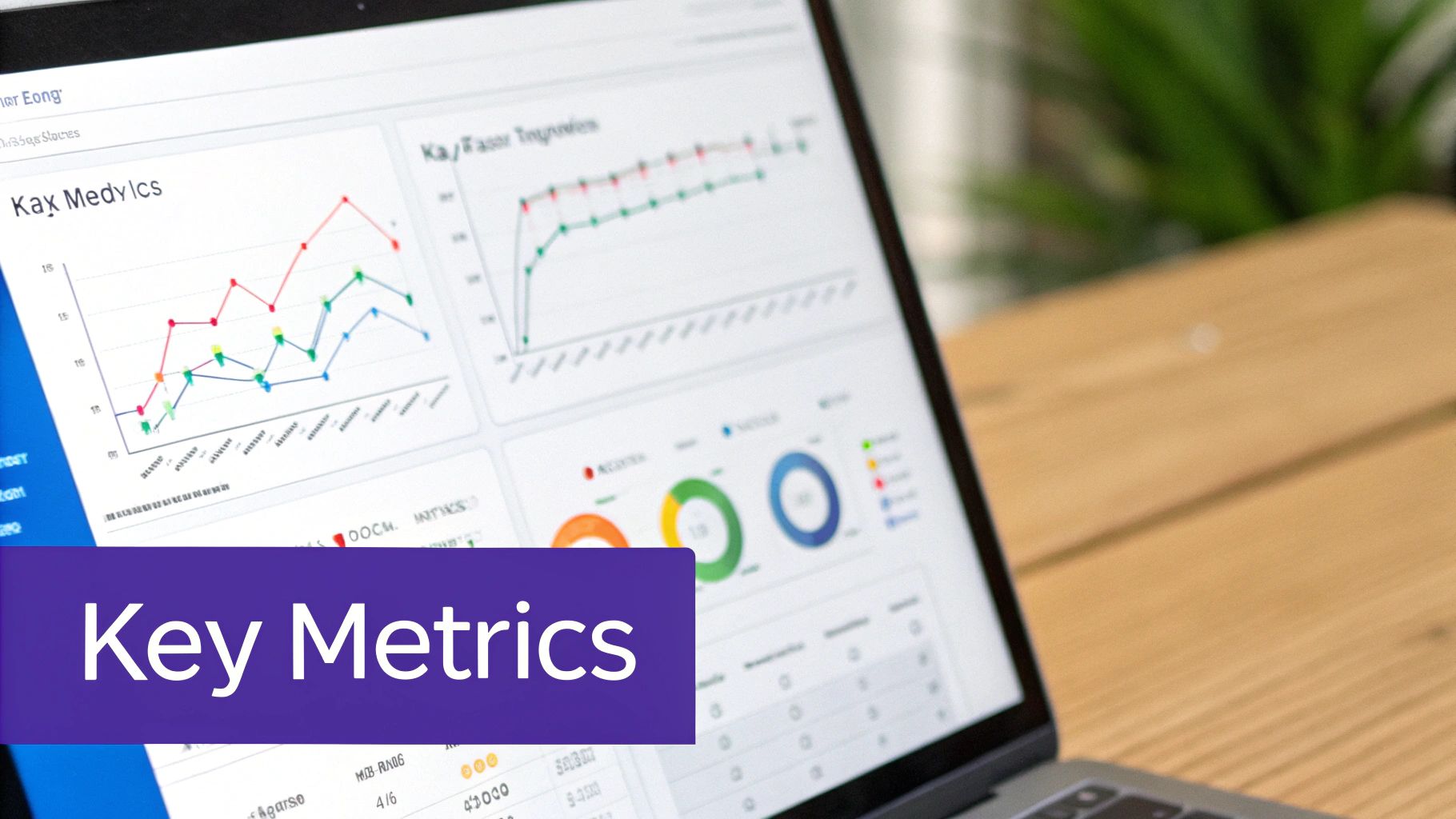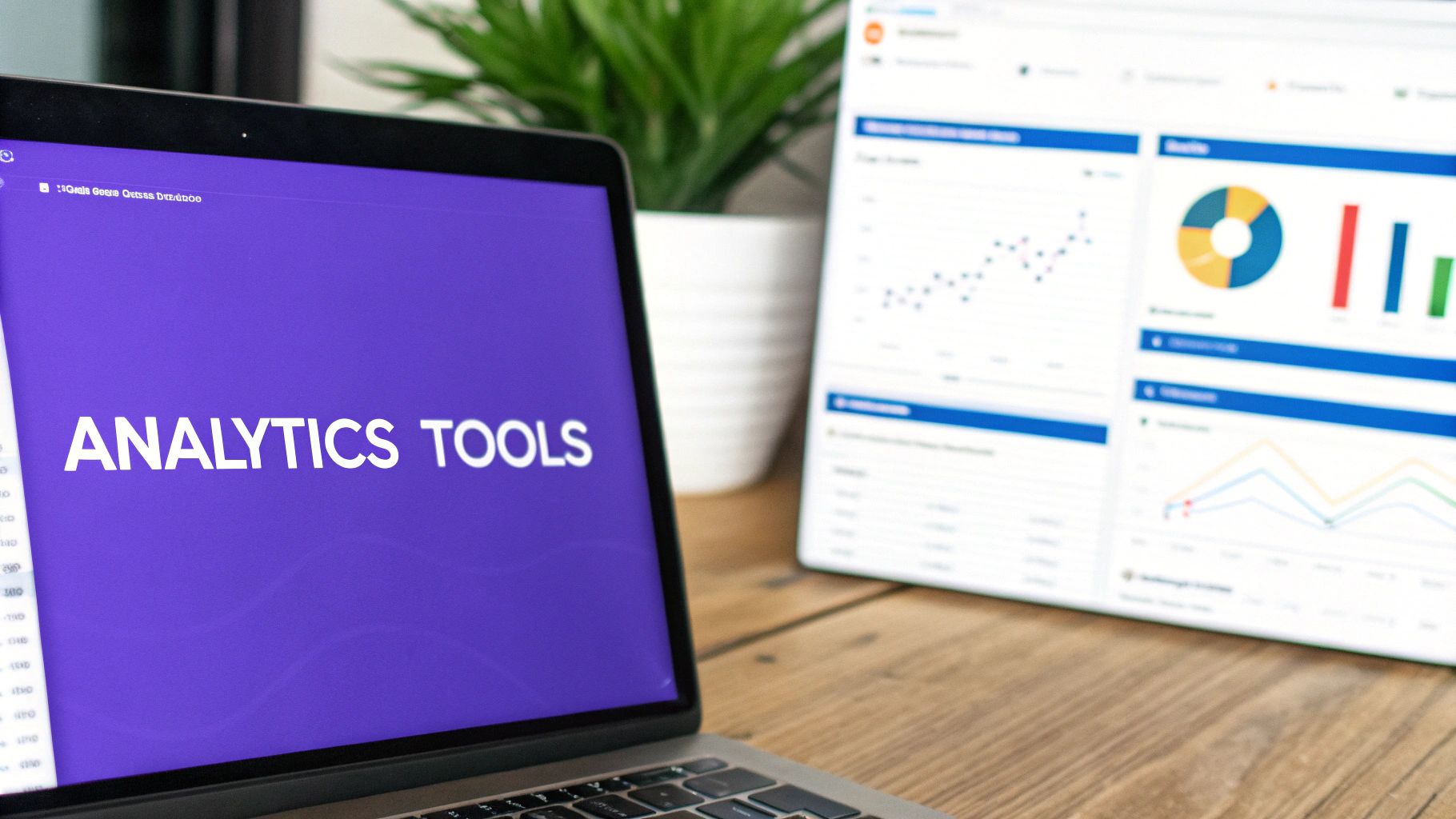How to Measure Social Media Success: Essential Tips
Learn how to measure social media success using actionable data insights and strategies that drive growth.
Posted by
Why Most Brands Fail at Social Media Measurement

Many brands find it challenging to truly measure their social media success. They often fixate on vanity metrics like follower counts and likes. However, these numbers don't always connect to real business results. It's like evaluating a fish on its ability to climb a tree – the measurement is completely irrelevant.
True social media success comes from aligning social media activities with overarching business goals. This requires a shift from simply tracking activity to measuring the actual impact of that activity.
The Problem With Vanity Metrics
Focusing only on vanity metrics can be deceptive. A large follower count, for instance, doesn't automatically translate into more sales or stronger brand loyalty. High engagement rates are good, of course, but they don't guarantee business growth.
These metrics provide a superficial view. They fail to reveal how social media truly affects your bottom line. A post might get tons of likes, but how many turned into website visits or purchases? That's the essential question vanity metrics often leave unanswered.
The Costly Mistake of Ignoring Business Outcomes
The biggest mistake brands make is disconnecting their social media efforts from tangible business results. This can lead to wasted resources and missed opportunities. Measuring social media success hinges on understanding its impact on key performance indicators (KPIs). Important KPIs include lead generation, customer acquisition cost, and brand awareness.
If your goal is driving website traffic, you need to track click-through rates from your social media posts. If you want to boost customer satisfaction, monitor social media sentiment and response times to customer inquiries.
The Solution: A Strategic Measurement Framework
Successful brands use a strategic approach to social media measurement. They define clear SMART goals (Specific, Measurable, Achievable, Relevant, and Time-Bound) that align with their overall business objectives. They track metrics that directly reflect those goals, such as conversion rates, website traffic, and lead generation.
These brands also use analytics tools like Google Analytics to gain deeper insights into audience behavior and campaign performance. By focusing on relevant metrics, these brands can make data-driven decisions that promote real business growth. This isn't about creating impressive reports; it's about uncovering actionable insights to refine social media strategies for maximum impact.
Crafting Social Goals That Actually Matter to Your Business

Before diving into metrics, it's essential to define what social media success truly means for your specific business. This goes beyond vanity metrics like likes and follower counts. True success lies in aligning your social media activity with your core business objectives. For instance, if lead generation is your primary goal, your social media strategy should prioritize driving traffic to landing pages where prospects can convert.
Aligning Social Media With Business Objectives
Start by pinpointing your core business goals. Is your focus on increasing brand awareness, boosting sales, enhancing customer service, or perhaps launching a new product? Once you've identified these overarching objectives, you can craft SMART social media goals that directly support them. A SMART goal is Specific, Measurable, Achievable, Relevant, and Time-Bound. This framework provides clarity for tracking progress and demonstrating the value of your social media initiatives.
Defining Key Performance Indicators (KPIs)
Defining and monitoring Key Performance Indicators (KPIs) is crucial for gauging social media success. Common KPIs include reach, impressions, and engagement rates. These metrics offer valuable insights into how widely your content is being seen and how effectively it resonates with your audience.
For example, as of 2020, the average engagement rate on Instagram hovered around 2.2%. This highlights that even a seemingly small percentage of engagement can significantly impact brand awareness and interaction. Tracking follower growth and demographics provides a deeper understanding of your audience composition, allowing you to tailor your content for specific target groups. Regularly monitoring these KPIs allows you to adapt your strategies for improved reach and engagement over time. Find more detailed statistics here: Learn more about measuring social media success
Establishing Realistic Benchmarks
Setting realistic benchmarks is key for accurately evaluating your social media performance. This involves researching industry averages, analyzing competitor performance, and considering your own historical data. A new business, for example, might target a lower initial engagement rate compared to a well-established brand with a large, dedicated following. Consistent KPI tracking and strategy refinement are key to gradually increasing engagement.
Developing a Measurement System That Scales
As your business and social media presence expand, your measurement system should adapt accordingly. Begin with a simple framework focusing on essential KPIs. Then, progressively integrate more sophisticated metrics and analytics tools as needed. Tools like EndorseFlow can streamline this process, consolidating your social media efforts into a unified and scalable system. This adaptability allows you to respond effectively to evolving market dynamics and maximize your social media marketing impact.
Decoding Engagement Metrics That Signal Genuine Connection

While getting likes and shares feels good, real social media success needs a deeper look at engagement quality. This means understanding what truly connects with your audience, not just counting surface-level interactions. Leading brands focus on analyzing the type of engagement, not just the quantity. This helps them understand how content contributes to bigger business goals.
Beyond Vanity Metrics: Understanding True Engagement
Measuring social media success means tracking key metrics like engagement, reach, and follower growth. Engagement metrics, including likes, comments, and shares, are crucial. They show how your audience interacts with your content. For example, in 2022, Facebook reported that video posts had much higher engagement than those without. This highlights how important content format is.
Calculating engagement rates for individual posts or overall helps identify top-performing content. This metric, often a percentage of the audience interacting with the content, lets businesses adjust strategies for better engagement. Learn more about measuring social media success here. This deeper understanding goes beyond vanity metrics and provides valuable insights into audience behavior.
Platform-Specific Metrics and Business Objectives
Different platforms prioritize different engagement types. On Instagram, high save rates might mean valuable, long-lasting content. On LinkedIn, comments and shares, especially in professional groups, show thought leadership and industry influence.
Aligning platform-specific metrics with your business goals is key. If your goal is brand awareness, focus on reach and impressions. But, if driving conversions is the priority, click-through rates and website traffic from social media become more important.
Identifying Patterns and Purchase Intent
Analyzing engagement patterns reveals a lot about your audience. Recurring themes in comments, frequently asked questions, and positive reactions to specific content types show audience interests and pain points. This information can shape content creation and product development.
Engagement can also signal purchase intent. High click-through rates on product-focused posts or frequent saves of shopping guides suggest a higher chance of conversion. Recognizing these signals allows for targeted ads and personalized messages.
Segmenting Engagement for Optimized Strategies
Segmenting your audience by demographics, interests, and customer journey stage allows for better targeting. You can tailor content and messaging to different segments, maximizing impact and optimizing organic reach and paid campaigns. You might be interested in: How to improve social media engagement.
For example, engaging new followers with introductory content is different from nurturing current customers with loyalty programs. This targeted approach builds stronger connections and makes your social media efforts more effective. Analyzing how different segments interact with various content formats further refines this approach. It ensures your message resonates with each specific group. Through this strategic segmentation and analysis, you can make social media engagement a powerful driver of business growth.
To understand what "good" engagement looks like, let's examine some industry benchmarks:
Engagement Rate Benchmarks by Platform This table compares average engagement rates across major social media platforms, helping readers understand what constitutes good performance in their industry.
| Social Platform | Average Engagement Rate | Good Engagement Rate | Excellent Engagement Rate |
|---|---|---|---|
| 0.5% - 1% | 1% - 2% | 2% + | |
| 1% - 3% | 3% - 5% | 5% + | |
| 0.3% - 0.5% | 0.5% - 1% | 1% + | |
| 1% - 2% | 2% - 3% | 3% + |
As you can see, engagement rates vary considerably across platforms. While a 1% engagement rate might be average on Instagram, it signifies excellent performance on Twitter. Understanding these benchmarks helps set realistic goals and measure your progress effectively.
Building Your Social Analytics Tech Stack Without Breaking the Bank

Navigating the world of social media analytics can be overwhelming. With so many tools available, it's easy to get lost. But building a powerful analytics system doesn't have to drain your resources. This section offers a practical guide to selecting the right solutions for your needs, no matter your budget.
Start With the Basics: Native Platform Analytics
Most social media platforms offer built-in analytics dashboards. These native analytics provide essential data on key metrics like engagement, reach, and follower demographics. They're a perfect starting point for startups and small businesses. For example, Facebook Insights offers detailed information on your audience, including demographics and interests, which can be extremely valuable for shaping your content strategy.
Leveraging Free Tools for Surprising Value
Several free third-party tools can significantly boost your basic analytics. Google Analytics, for example, lets you track website traffic from social media. This helps you understand which platforms are driving conversions. Using techniques like UTM tracking can further enhance your measurement capabilities. UTM tracking involves adding unique codes to your shared links, allowing you to precisely monitor campaign performance across various platforms and content. Discover more insights about social media metrics. Combining these free tools creates a more robust measurement system without increasing your costs.
When to Invest in Premium Analytics Solutions
As your business expands, consider investing in premium social media management platforms. These tools typically provide advanced features such as competitive analysis, sentiment tracking, and detailed reporting. They can also automate tasks like scheduling posts and managing multiple accounts, saving you time and resources.
Building an Integrated Measurement System
No matter which tools you choose, ensure your analytics tech stack works together seamlessly. Centralize your data collection and reporting to avoid information silos. Platforms like EndorseFlow can streamline this process, combining testimonial collection and social media management into a single platform. This integration connects engagement with customer feedback, providing a holistic view of your brand's social media performance. How to master your social media content calendar. This coordinated approach improves efficiency and provides a more comprehensive understanding of social media's impact on your business goals. By carefully assessing your needs and strategically selecting tools, you can build a strong analytics tech stack without overspending, focusing on what truly matters: turning data into actionable insights for social media success.
Connecting Social Media Metrics to Your Bottom Line
Measuring social media success goes beyond simple vanity metrics like likes and shares. It's about demonstrating a real impact on your bottom line. This means connecting your social media activities to tangible outcomes like revenue generation, customer acquisition, and overall business growth. While this can be complex, it's essential for securing stakeholder buy-in and justifying continued investment.
Understanding Attribution Models
Attribution models help determine how much each marketing touchpoint contributes to a conversion, including social media. The simplest model is last-click attribution, giving all the credit to the final click before a purchase.
However, this overlooks social media's role in earlier stages of the customer journey, such as building brand awareness and nurturing leads. More sophisticated models, like multi-touch attribution, consider all customer interactions across different channels.
For example, a customer might discover your product through a social media ad, then visit your website via a search engine, and finally purchase after clicking an email link. Multi-touch attribution assigns credit to each interaction, revealing social media's overall contribution, even if it wasn't the final click.
Calculating Customer Acquisition Cost (CAC) from Social Channels
Knowing your Customer Acquisition Cost (CAC) from social media is crucial. CAC is calculated by dividing your total social media marketing spend by the number of customers acquired through those channels.
This metric helps compare social media's cost-effectiveness against other marketing channels and informs budget allocation. For instance, if you spend $1,000 on social media and acquire 100 customers, your CAC is $10. Tracking CAC ensures your social media marketing remains profitable.
Determining Lifetime Value of Social-Acquired Customers
Customer Lifetime Value (CLTV) estimates the total revenue a customer generates throughout their relationship with your brand. Understanding the CLTV of customers acquired through social media is essential for assessing long-term ROI.
This can be calculated by tracking the average purchase value and purchase frequency of these customers. A high CLTV justifies a higher CAC from social channels. This long-term profitability perspective is crucial for sustainable social media marketing.
Building Compelling ROI Models for Executives
Executives need to see a clear return on investment in social media. A robust ROI model connects social media metrics to revenue. This involves tracking key metrics like leads generated, conversions, and sales influenced by social media.
Clear, data-driven reports showcasing the impact of social media on business goals are vital for securing buy-in and demonstrating your strategy's value.
Social Media ROI Calculation Methods
The following table outlines various approaches to calculating social media ROI, from basic formulas to more advanced attribution models.
| Calculation Method | Formula | Best Used For | Limitations |
|---|---|---|---|
| Basic ROI | (Return - Investment) / Investment | Simple campaigns with clear conversion goals | Doesn't account for long-term impact or multi-touch attribution |
| Cost Per Acquisition (CPA) | Total Social Media Spend / Number of Conversions | Measuring the cost-effectiveness of acquiring customers | Doesn't reflect customer lifetime value |
| Multi-Touch Attribution | Varies based on model | Understanding the contribution of all touchpoints | Can be complex to implement and requires robust tracking |
By connecting social media metrics to revenue and demonstrating ROI, you can prove the value of your social media efforts and secure continued investment. Platforms like EndorseFlow can streamline this by integrating testimonial collection and social media management, allowing you to connect engagement with customer feedback for a more comprehensive view of your brand's social media performance.
Transforming Data Into Decisions That Drive Growth
Having tons of social media data is only half the battle. The real value lies in turning that data into actionable insights that fuel business growth. This involves building a system for analyzing, interpreting, and using your findings to refine your strategies. This section explores how successful brands leverage data to make informed decisions that deliver tangible results.
Structuring Your Reporting Process
Effective reporting ensures valuable information reaches the right people in an understandable format. This begins with clear, concise reports focusing on key metrics aligned with business objectives. For instance, a marketing team report might highlight engagement and reach, while an executive report would emphasize ROI and lead generation.
Visualizations, such as charts and graphs, simplify complex data. Tools like Dashboards) provide real-time overviews of key metrics, allowing for quick identification of trends and potential problems. This streamlined approach ensures data-driven decisions are made promptly and efficiently.
Visualizing Social Data for Different Stakeholders
Different stakeholders need different data visualizations. Executives may prefer high-level overviews of key performance indicators (KPIs), while content creators benefit from detailed breakdowns of post performance.
For example, a line graph illustrating follower growth over time suits executives. A bar chart comparing engagement rates for different content types is more helpful for content creators. Tailoring visualizations ensures everyone has the necessary information to optimize their work.
Creating Continuous Improvement Cycles
Top organizations create continuous improvement cycles, where measurement directly informs future strategies. This iterative process involves:
-
Analyzing Data: Identifying trends, patterns, and areas for improvement.
-
Implementing Changes: Adjusting content strategy, audience targeting, or resource allocation based on the data.
-
Measuring Results: Tracking the impact of changes and analyzing the new data.
This cyclical approach ensures your social media strategy stays aligned with your business goals and adapts to changing audience behavior. Regular social media audits enhance this process by providing a comprehensive performance evaluation and identifying new growth opportunities. You might be interested in: How to master your testimonial marketing strategy.
Conducting Comprehensive Social Media Audits
Regularly auditing your social media presence is crucial for adapting to evolving trends. A social media audit includes:
-
Analyzing Your Audience: Understanding demographics, interests, and online behavior.
-
Evaluating Your Competitors: Identifying what works for them and uncovering potential opportunities.
-
Reviewing Your Content: Analyzing top-performing posts and identifying areas for improvement.
-
Assessing Your Platform Usage: Determining which platforms drive the most engagement and align with your target audience.
These audits help align your measurement framework with business priorities, adapting to changes in platform algorithms and audience behavior.
By transforming data into actionable insights through these strategies, you can continuously improve social media performance and drive significant business growth. Want to improve your social media management and testimonial collection? Discover how EndorseFlow can help achieve your social media goals and amplify your brand message with authentic customer testimonials.